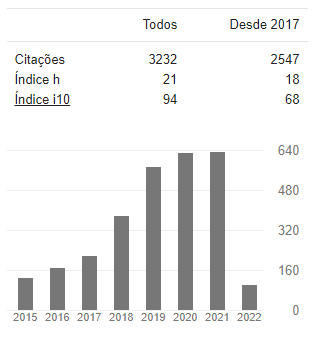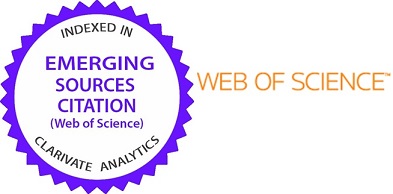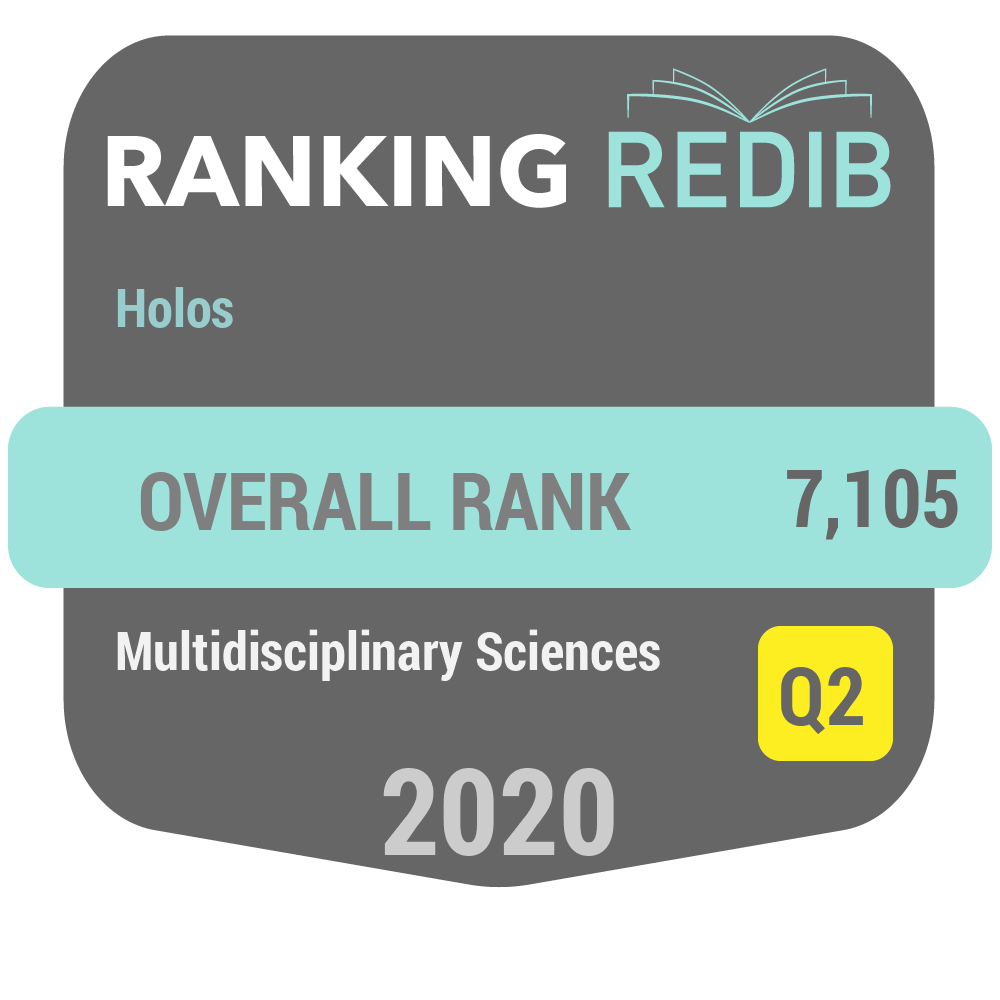Atributos antecessores à satisfação e à confiança no serviço de Internet Banking
DOI:
https://doi.org/10.15628/holos.2020.7116Palavras-chave:
Satisfação, Confiança, Internet BankingResumo
Este artigo identifica os atributos que são antecedentes à geração de confiança e satisfação para os usuários dos serviços internet banking. Trata-se de uma pesquisa do tipo survey que contou com a participação de 449 respondentes brasileiros. Os dados foram tratados utilizando procedimento estatístico de sistematização dos dados, análise fatorial exploratória, validade de construto, construção de escalas, análise fatorial confirmatória e modelagem de equações estruturais. O modelo teórico é formado por sete hipóteses sobre a relação entre confiança, satisfação, usabilidade, reputação e privacidade/segurança. No modelo proposto os construtos para confiança e satisfação aparecem como variáveis regressoras e apresentam um bom nível de confiabilidade permitindo que seja observada a sua importância na prestação de serviços de internet banking. Os resultados sinalizam que níveis mais elevados de usabilidade, reputação e privacidade/segurança proporcionados pelos usuários deste serviço contribuem para melhores graus de confiança e de satisfação. A forma com que as pessoas veem o serviço de internet banking, ao comparar os produtos e serviços oferecidos por outros sites de bancos concorrentes, se relacionam positivamente com a confiança e satisfação depositada na prestação do serviço. Os resultados mostram também que a confiança dos usuários na utilização do serviço de internet banking não é um antecessor do grau de satisfação do mesmo.Downloads
Métricas
Referências
ARCAND, Manon et al. Mobile banking service quality and customer relationships. International Journal of Bank Marketing, v. 35, n. 7, p. 1068-1089, 2017.
BAILEY, J.; PEARSON, S. Development of a tool for measurement and analyzing computer user satisfaction. Management Science, 29(5), pp. 530 -575, 1983.
BAUER, H. H.; GRETHER, M.; LEACH, M. Building Customer Relations Over the Internet. Industrial Marketing Management, 31, pp. 155-163, 2002.
BART, Y.; SHANKAR, V.; SULTAN, F.; URBAN, G. L. Are the Drivers and Role of Online Trust the Same for All Web Sites and Consumers? A Large-Scale Exploratory Empirical Study. Journal of Marketing, 69, pp. 133-152, oct. 2005.
BERRY, L. Relationship marketing of services – perspectives from 1983 and 2000. Journal of Relationship Marketing, 1 (1), pp. 59-77, 2002.
BREI, V. A.; ROSSI, C. A. V. Confiança, Valor Percebido e Lealdade em Trocas Relacionadas de Serviço: Um Estudo com Usuários de Internet Banking no Brasil. RAC, 9 (2), pp. 145-168, 2005.
BUTT, M. M.; AFTAB, M. Incorporating attitude towards Halal banking in an integrated service quality, satisfaction, trust and loyalty model in online Islamic banking context. International Journal of Bank Marketing, 31(1), pp. 6-23, 2013.
CASALÓ, L.; CARLOS, F.; GUINALÍU, M. The Generation of Trust in the Online Services and Product Distribution: The case of Spanish Electronic Commerce. Journal of Electronic Commerce Research, 12 (3), pp. 199-213, 2011.
CORRITORE, C., KRACHER, B; WIEDENBECK, S. On-Line Trust: Concepts, Evolving Themes, a Model. International Journal of Human-Computer Studies, 58 (6), pp. 737-758, 2003.
ENNEW, C.; SEKHON, H. Measuring trust in financial services: the Trust Index. Conxumer Policy Review, 17 (2), mar./apr. 2007.
FÁVERO, L. P.; BELFIORE, P.; SILVA, F. L.; CHAN, B. L. Análise de dados: modelagem multivariada para tomada de decisões. 1 ed. Rio de Janeiro: Elsevier, 646p, 2009.
FEBRABAN, “Pesquisa FEBRABAN de Tecnologia Bancária 2019”, 2019. Disponível em: < https://portal.febraban.org.br/pagina/3106/48/pt-br/pesquisa > Acesso em 27/08/2019.
FLAVIÁN. C.; M. GUINALÍU. Consumer Trust, Perceived Security, and Privacy Policy: Three Basic Elements of Loyalty to a Website. Industrial Management and Data Systems, 106 (5), pp. 601-620, 2006.
GEORGE, A.; KUMAR, G. S. G. Validation of a scale for measuring problems in internet banking and their effect on customer satisfaction. Vision: The Journal of Business Perspective. Vol. 19, nº 4, pp. 312-323, dec. 2015.
GERRARD, P.; CUNNINGHAM, J. B.; DEVLIN, J. F. Why consumers are not using internet banking: a qualitative study. Journal of Services Marketing, 20 (3), pp. 160–168, 2006.
GIOVANNINI, C. J.; NUNES, D. C. G.; FERREIRA, D. B. Satisfação e Confiança do Consumidor em Ambientes Virtuais de Corretoras de Valores. Anais do XXXVI Encontro da ANPAD, Rio de Janeiro, 2012.
GRÖNROOS, C. Service management and marketing: a customer relationship management approach. 2 ed. England: Wiley, p. 394, 2000.
GUPTA, K. K.; BANSAL, I. Development of an Instrument to Measure Internet Banking Service Quality in India. Journal os Arts, Science & Commerce, 3 (2), apr. 2012.
GUTMAN, L. F. D.; JOIA, L. A.; MORENO JR., V. A. Antecedentes da intenção de uso de sistemas de home broker sob a ótica dos investidores do mercado acionário. Revista de Administração, 49 (2), pp. 353–368, 2014.
HAIR, J. F.; TATHAM, R. L.; ANDERSON, R. E.; BLACK, W. Análise multivariada de dados. 6.ed. Porto Alegre: Bookman, 688p, 2009.
HANSON, W. Principles of internet marketing. Cincinnati: South-Western College Publishing, 2000.
HERNANDEZ, J. M. D. C.; MAZZON, J. A. Um estudo empírico dos determinantes da adoção de Internet Banking entre não usuários brasileiros. Revista de Administração Contemporânea, 12, p. 9–39, 2008.
IBRAHIM, E. N. M.; NOOR, N. L. M; MEHAD, S. Trust or distrust in the web-mediated information environment (W-MIE): A perspective of online Muslim users. Journal os Enterprise Information Management, 22(5), pp. 523-547, 2009.
IVES, B., OLSON, M.; BAROUDI, S. The measurement of user information satisfaction. Communications of the ACM, 26(10), pp. 785–793, 1983.
JARVENPAA, S. L.; TRACTINSKY, N.; VITALE, M. Consumer trust in an internet store. Information Technology and Management, 1 (1), pp. 45-71, 2000.
JOSANG, A.; ISMAIL, R.; BOYD, C. A Survey of Trust and Reputation Systems for Online Service Provision. Decision Support Systems, 43 (2), pp. 618–644, 2007.
KANTOWITZ, B. H.; HANKOWSKI, R. J.; KANTOWITZ, S. C. Driver Acceptance of Unreliable Traffic Information in Familiar and Unfamiliar Settings. Human Factors, 39 (2), pp. 164–176, 1997.
KESHARWANI, A.; BISHT, S. S. The impact of trust and perceived risk on internet banking adoption in India: An extension of technology acceptance model. International Journal of Bank Marketing, 30 (4), pp. 303–322, 2012.
KHAN, Imran; RAHMAN, Zillur. Brand experience and emotional attachment in services: The moderating role of gender. Service Science, v. 9, n. 1, p. 50-61, 2017.
KLINE, P. The handbook of psychological testing. Routledge: London, 2000.
KLINE, R.B. Principles and practice of structural equation modeling. New York London: The Guilford Press. 2 ed, 366p, 2005.
KOLSAKER, A.; PAYNE, C. Engendering Trust in e-Commerce: A Study of Gender-based Concerns. Marketing Intelligence and Planning, 20 (4), pp. 206-214, 2002.
KOMIAK, S. X.; BENBASAT, I. Understanding Customer Trust in Agent-Mediated Electronic Commerce, Web-Mediated Eletronic Commerce, and Traditional Commerce. Information Technology and Management, 5 (1), pp. 181-207, jan. 2004.
LEE, N.; HOOLEY. G. The evolution of “classical mythology” within marketing measure development. European Journal of Marketing, 39 (3/4), pp. 365- 385, 2005.
LI, Y. Empirical studies on online information privacy concerns: literature review and an integrative framework. Communications of the Association for Information Systems, [S.l.], v. 28, n. 1, p. 453-496, 2011.
LIAO, Z.; CHEUNG, M. T. Measuring consumer satisfaction in internet banking: a core framework. Communications of the ACM, 51 (4), pp. 47-51, 2008.
LIAO, C.; LIU, C. C.; CHIEN, K. Examining the impact of privacy, trust and risk perceptions beyond monetary transactions: an integrated model. Electronic Commerce Research and Applications, [S.l.], v. 10, n. 6, p. 702-715, 2011.
LIÉBANA?CABANILLAS, F.; MUÑOZ?LEIVA, F.; REJÓN?GUARDIA, F. The determinants of satisfaction with e-banking. Industrial Management & Data Systems, 113(5), pp. 750-767, 2013
LOEBBECKE, C.; HORNIG, V. Increasing trust in e-commerce: concepts and examples of insurance solutions. In: 14TH Bled Electronic Commerce Conference. Bled, Slovenia. June. 2001.
MA, Z. Assessing Serviceability and Reliability to Affect Customer Satisfaction of Internet Banking. Journal of Software, 7 (7), 2012.
MARÔCO, J. Análise de Equações Estruturais: fundamentos teóricos, software & aplicações. 1ª ed. Lisboa – Portugal, ReportNumber, 2010.
MARÔCO, J. Análise Estatística com o SPSS Statistics. 5ª ed. Lisboa – Portugal, ReportNumber, 2011.
MELONE, N.P. A theoretical assessment of the user satisfaction construct in information systems research. Management Science, pp. 76-91, 1990.
MORGAN, R.; HUNT, S. The Commitment-Trust Theory of Relationship Marketing. Journal of Marketing, 58 (3), pp. 20-38, Jul. 1994. MORGAN-THOMAS, A.; VELOUTSOU, C. Beyond technology acceptance: Brand relationships and online brand experience. Journal of Business Research, 66 (1), pp. 21–27, 2013.
MOORMAN, C.; DESHPANDÉ, R.; ZALTMAN, G. Factors Affecting Trust in Market Research Relationships. Journal of Marketing, 57 (1), pp. 81-101, Jan. 1993.
MOUTINHO, L.; SMIT, A. Modelling bank customer satisfaction through mediation of attitudes towards human and automated banking. International Journal of Bank Marketing, 18 (3), pp. 124-134, 2000.
MUIR, B. M.; MORAY, N. Trust in automation: Part H Experimental studies of (rust and human intervention in a process control simulation. Ergonomics, 39 (3), pp. 429-461, 1996.
OFORI, Kwame Simpe et al. Examining customers’ continuance intentions towards internet banking usage. Marketing Intelligence & Planning, v. 35, n. 6, p. 756-773, 2017.
O´MALLEY, L.; TYNAN, C. Relationship marketing in consumer markets – rhetoric or reality? European Journal of Marketing, 34(7), pp. 797-815, 2000.
POLATOGLU, V. N.; EKIN, S. An empirical investigation of the Turkish consumers' acceptance of internet banking services. International Journal of Bank Marketing, 19 (4), pp. 156-165, 2001.
PRADO, E. P. V. Sites de Internet Banking: Uma Avaliação da Qualidade Baseada no Modelo Webqual. Gestão & Regionalidade. 26 (77), 2010.
RIQUELME, H. E.; MEKKAOUI, K. A.; RIOS, R. E. Internet Banking Customer Satisfaction and Online Service Attributes. Journal of Internet Banking and Commerce, 14 (2), 2009.
ROUSSEAU, D. M.; SITKIN, S. B.; BURT, R. S.; CAMERER, C. Not so Different After All: A Cross Discipline View of Trust. The Academy of Management Review, 23 (3), pp. 393-404, Jul. 1998.
ROOSTIKA, RATNA Perceived service quality and trust on satisfaction: customer’s perspectives in the banking sector. Jurnal Keuangan dan Perbankan, 15(2), pp. 271-280, 2011.
SAFEENA, R.; KAMMANI, A.; DATE, H. Assessment of Internet Banking Adoption: An Empirical Analysis. Arabian Journal for Science and Engineering, 39 (2), p. 837–849, 2014.
SANTOS, T. S.; CONDE, D. R.; SANTOS, T. S.; ANTONIALLI, L. M. Internet Banking: perfil do usuário e qualidade percebida pelos clientes bancários de Lavras/MG. Anais do III Encontro de Administração da Informação, Porto Alegre, 2011.
SEDDON, P. B. A Respecification and Extension of the DeLone and McLean Model of IS Success. Information Systems Research, 8 (3), pp. 240-253, 1997.
SELNES, F. Antecedents and Consequences of Trust and Satisfaction in Buyer-Seller Relationships. European Journal of Marketing, 32 (3), pp. 305-322, 1998.
SIKDAR, P.; KUMAR, A.; MAKKAD, M. Online Banking Adoption: A Factor Validation and Satisfaction Causation Study in the Context of Indian Banking Customers. International Journal of Bank Marketing, 33 (6), p. 760–785, 2015.
SUSANTO, A.; CHANG, Y.; HA, Y. Determinants of continuance intention to use the smartphone banking services: An extension to the expectation-confirmation model. Industrial Management & Data Systems, 116 (3), pp. 508-525, 2016.
TWUM, F.; AHENKORA, K. Internet Banking Security Strategy: Securing Customer Trust. Journal of Management and Strategy, 3 (4), pp. 78–83, 2012.
VIACAVA, J. J. C.; MANTOVANI, D.; KORELO, J. C.; PRADO, P. H. M. Vieses na satisfação: o efeito moderador da dificuldade e da obrigação sobre recordações positivas e negativas. Revista Eletrônica de Administração, 81 (2), pp. 437-461, 2015.
WIXOM, B. H.; TODD, P. A. A theoretical integration of user satisfaction and technology acceptance. Information Systems Research, 16(1), pp. 85-102, 2005.
YOUSAFZAI, S. Y.; FOXALL, G. R.; PALLISTER, J. G. Explaining internet banking behavior: theory of reasoned action, theory of planned behavior, or technology acceptance model? Journal of Applied Social Psychology, 40 (5), pp. 1172-1202, 2010.
YU, P. L.; BALAJI, M. S.; KHONG, K. W. Building trust in internet banking: a trustworthiness perspective. Industrial Management & Data Systems, 115 (2), pp. 235-252, 2015.
ZHAO, A. L.; LEWIS, N. K.; HANMER-LLOYD, S. & WARD, P. Adoption of internet banking services in China: is it all about trust? International Journal of Bank Marketing, 28 (1), pp. 7-26, 2010.
ZHU, Y.; CHEN, H. Service fairness and customer satisfaction in internet banking. Internet Research, 22 (4), pp. 482–498, 2012.









































